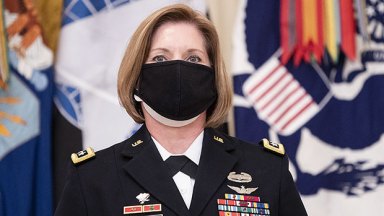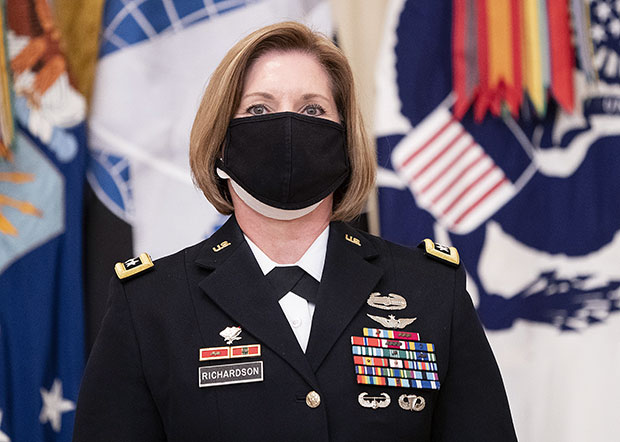
President Joe Biden commemorated International Women’s Day (March 8) by nominating two female generals to 4-star commands: Air Force General Jacqueline Van Ovost and Lt. General Laura Richardson. Upon confirmation by the Senate, General Van Ovost will head the United States Transport Command, while Lt. General Richardson will commander the United States Southern Command. The promotions – which would give General Richardson her fourth star – would make them the second and third women to lead a Combat Command.
“Each of these women have led careers demonstrating incomparable skill, integrity, and duty to country,” President Biden, 78, said in a Monday press conference, per CNN. “And at every step, they’ve also helped push open the doors of opportunity to women in our military, blazing the trail, a little wider, a little brighter, for all proud women following their path and looking to their example.” As these women await their confirmation, here’s what you need to know about Lt. General Laura Richardson.
1. Her Promotion Was Postponed In 2020
Like General Van Ovost, Lt. General Richardson’s nomination to the position was delayed not because the Pentagon didn’t think she qualified for the job. The delay was out to fear that former President Donald Trump, with his sexist history, wouldn’t support appointing women to the positions. “I didn’t want their promotions derailed because someone in the Trump White House saw that I recommended them or thought [the Department of Defense] was playing politics,” former Defense Secretary Mark Esper told The New York Times. “This was not the case. They were the best qualified. We were doing the right thing.”

2. Lt. Gen. Richardson Will Oversee SOUTHCOM
What will Lt. General Richardson be in charge of? The United States Southern Command, aka SOUTHCOM, is “is responsible for providing contingency planning, operations, and security cooperation in its assigned Area of Responsibility which includes Central America, South America, and The Caribbean (except U.S. commonwealths, territories, and possessions),” according to its official website. “The command is also responsible for the force protection of U.S. military resources at these locations. SOUTHCOM is also responsible for ensuring the defense of the Panama Canal. Under the leadership of a four-star commander, SOUTHCOM’s staff is organized into directorates, component commands, and Security Cooperation Organizations that represent SOUTHCOM in the region.”
“Gen. Van Ovost and Lt. Gen. Richardson have been tested under the most difficult circumstances, and they are proven leaders,” Vice President Kamala Harris said on Monday, per Stars And Stripes. “The president and I have full confidence in them to address the complex threats we face, to help lead our troops, and to keep our nation safe.”
3. Lt. Gen. Richardson Has An Impressive Resume
Lt General Richardson was born Jane Strickland and “grew up in Colorado and was commissioned a Second Lieutenant of Aviation upon graduation from Metropolitan State College in Denver,” according to her profile on the Association of the United States Army website. Her first assignment in flight school was in Korea, as part of the 17th Aviation Brigade (where she served as “Platoon Leader, Company Executive Officer, Brigade Staff Officer, and Company Commander.”) She then served at Fort Hood in Texas, on the III Corps staff, and in the 6th Cavalry Brigade as a Company Commander and Brigade Adjutant.

She was assigned to For Leavenworth’s Battle Command Training Program as an observer trainer before attending the United States Army Command and General Staff College. She also served as an Assault Helicopter Battalion Operations Officer at For Campbell and as an Executive Officer with the 9th Battalion, 101st Aviation Regiment, 101st Airborne Division (Air Assault). She also served as a military aide to the Vice President at the White House before returning to Fort Campbell to serve as the Division Deputy G-3 of the 101 st Airborn Division (Air Assault.) She later commanded the 5th Battalion, 101 st Aviation Regiment, and was deployed in Iraq as part of Operation IRAQI FREEDOM.
After combat, she served as Deputy Director, then the actual Director, for the Army’s Transformation Office at the Pentagon. After that, she served as the 100th Garrison Commander of Fort Myer and Fort McNair and the Joint Base Commander of Myer-Henderson Hall. Lt. General Richardson has also served as the Army’s Liaison Officer to the U.S. Senate, so she is more than equipped to handle this job.
4. She Has A Family
Sometime in between doing all of those previously mentioned assignments, Lt. General Richardson fell in love. She’s married to Lt. General James M. Richardson, currently the deputy commander for combat development at the Army Futures Command. They have one daughter and one grandchild.
4. Gen. Richardson Has A Keen Mind
Lt. General Richardson’s 2019 interview with Army.com highlights her strategic mind and why she will benefit SOUTHCOM. One of the more poignant – and most layperson – quotes came towards the end when she was asked the biggest lesson she’s learned throughout her career. “The fundamental lesson is that a commander’s most valuable resource is time. The way commanders go about spending it for their units is of the utmost importance,” said the Lt. General.
“The other lesson I offer is that readiness is all about being proactive,” she added. “It’s personal initiative, and it’s responsibility. Prior to addressing manning and equipping, commanders must understand that achieving readiness rates comes down to the individual Soldier being mentally and physically prepared to conduct training. Only after the individual Soldier is prepared can commanders plan and execute collective training of squads, platoons, companies, and battalions.”


